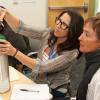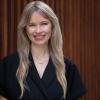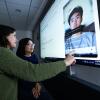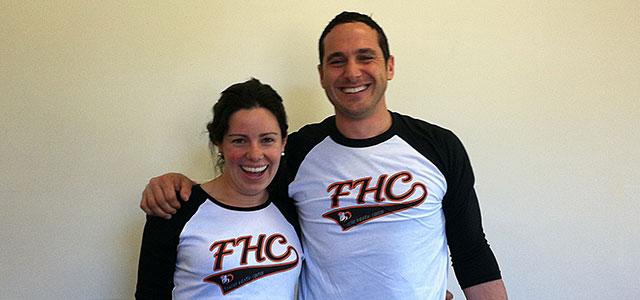
Caroline Castillo and Chris Contini
NP Students and Family Medicine Residents Model the Future of Health Care
While there has never been anything easy or formulaic about the clinical training of primary care providers, in recent years the challenge has stiffened. A shortage of primary care clinicians and the promised benefits of team-based care have institutions scrambling to teach physicians, nurse practitioners (NPs) and physician assistants (PAs) to work with each other – and with nurses, pharmacists, behavioral health specialists, social workers, practitioners of integrative medicine and others.
The problem is that training people to do such work efficiently and effectively defies easy or single-source solutions – to say nothing of the ongoing challenge of finding quality clinical placements. UC San Francisco School of Nursing – one of the nation’s leading educational institutions for nurse practitioners – is among those exploring options.
At the San Francisco VA Medical Center (SFVAMC), for example, second-year NP students from the School train side by side with second-year medical residents and within a broader team as part of a collaborative arrangement with UC San Francisco School of Medicine and the SFVAMC. The School also partners with UCLA School of Nursing on an NP residency program, where NP graduates hone their clinical skills in community clinics as part of a provider team. NP students at UCSF also continue to work collaboratively in clinical rotations throughout the San Francisco Bay Area.
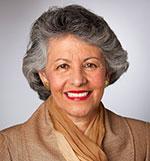 Pilar Bernal de Pheils In one such rotation at San Francisco General Hospital’s Family Health Center (FHC), some NP students learn alongside experienced NPs, but other students do a yearlong clinical rotation with third-year medical residents. And at a luncheon in 2013 to honor both the mentor-residents and the graduating NP students, the participants spoke so movingly about the value of this interdisciplinary, team-based training that the School’s Pilar Bernal de Pheils, who organized the luncheon, was taken by surprise. The mutual respect was palpable, she says, and both the physicians and NPs spoke unprompted about the fertile learning environment the arrangement created.
Pilar Bernal de Pheils In one such rotation at San Francisco General Hospital’s Family Health Center (FHC), some NP students learn alongside experienced NPs, but other students do a yearlong clinical rotation with third-year medical residents. And at a luncheon in 2013 to honor both the mentor-residents and the graduating NP students, the participants spoke so movingly about the value of this interdisciplinary, team-based training that the School’s Pilar Bernal de Pheils, who organized the luncheon, was taken by surprise. The mutual respect was palpable, she says, and both the physicians and NPs spoke unprompted about the fertile learning environment the arrangement created.
“We knew it was a successful program, but hearing them speak made clear just how rich their experience was,” says Bernal de Pheils.
The former NP students – who are now working in team-based clinical settings – seem genuinely appreciative of the enthusiasm and skill sets of the residents, the collaborative work, the broad focus of family medicine and the gritty, diverse patient population at San Francisco General. That combination, the NPs say, proved an exciting and rewarding training ground.
Ordinary and Extraordinary
“Watching the way [NP student] Chris [Contini] and his adolescent patient were enjoying their encounter taught me about watching the person you’re trying to teach so you understand what excites and motivates them about medicine and patient care. I learned a lot about Chris’s strengths; his open attitude toward adolescents is something I haven’t quite gotten myself.”
—Mentor and third-year resident Caroline Castillo
“She gave me that feedback right afterwards. I guess I didn’t view myself as having expertise in working with adolescents.… [I]t was the first time that it went beyond me seeing it as a personality trait.”
—Chris Contini
The basic outline of the yearlong rotation at the FHC is fairly straightforward, with each day following a routine that would be familiar at many clinical training grounds. It begins with the NP students and residents working through a list of the day’s patients.
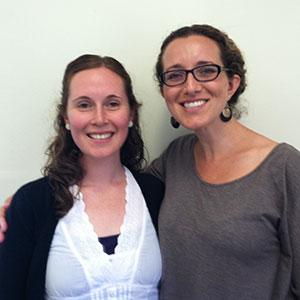 Jennifer Brodsky and Heather Bennett “I would identify several patients who I thought would provide a good learning experience, then go through their medical history [and] past visit summary and set a basic agenda for maintenance and results,” says physician Heather Bennett, about working with NP student Jennifer Brodsky. Brodsky is now a practicing NP at La Clínica de La Raza in Oakland, California, while Bennett is doing a fellowship in geriatric medicine at UCSF.
Jennifer Brodsky and Heather Bennett “I would identify several patients who I thought would provide a good learning experience, then go through their medical history [and] past visit summary and set a basic agenda for maintenance and results,” says physician Heather Bennett, about working with NP student Jennifer Brodsky. Brodsky is now a practicing NP at La Clínica de La Raza in Oakland, California, while Bennett is doing a fellowship in geriatric medicine at UCSF.
In the first weeks of the program, NP students largely shadow the residents, but most NP students quickly move into doing an initial patient meeting on their own. After that meeting, the NP student presents to the resident, including making suggestions for the treatment plan. Then the dyad returns to the exam room together, where the resident confirms the NP student’s work and, perhaps, does some teaching around various skills. The pair concludes with a discussion of any necessary prescriptions, referrals or patient education. Over time, the NP students take on more responsibility: seeing more patients each day and, often, helping with postvisit documentation.
In addition, says Bennett, “In between clinic visits, all communications would come to me, and if there was anything pertinent, I would try to email Jennifer and give her some learning topics. For example, if we saw a patient and a lab came back abnormal, I’d try to turn it into a learning opportunity about next steps.”
Within this learning structure, both the NP students and residents seemed energized by the extraordinary breadth of cases and cultures they encounter at the FHC. “In the course of a day, I might move from caring for a 22-year-old from Yemen who was in her second trimester of pregnancy to a newborn evaluation and then to a 76-year-old with osteoporosis,” says Brodsky.
“Learning how to work with patients from different cultural backgrounds and becoming competent in how to use interpreters – these things are hard to learn in the classroom,” says NP Rachel Larson, who is now practicing at West Berkeley Family Practice in Berkeley, California.
“You see so many different things in a family health care setting – OB, pediatric, geriatric, chronic kidney failure. The experience is so wide and so interesting,” says Contini, who now practices at Salud Para La Gente in Santa Cruz, California. “You also see patients again and again. I saw an OB patient who was having her first child from the time we diagnosed her pregnancy to the last exam. It solidified for me that I’d made the right decision about going into primary care.”
Bennett points to Brodsky’s first visit with a single mother and her twin toddlers as an example of learning opportunities in family care. “Jennifer dealt with it appropriately, but she felt a little overwhelmed because there was so much activity in the room,” says Bennett. “So we problem-solved for the next visit: a family member could take one of the toddlers so Jennifer could see one patient at a time. In the end, she saw the family multiple times, took care of both the mom and the kids and developed a sense of confidence and real efficiency. That’s a really difficult clinical skill – to connect with people, deal with the clinical issues, ask about community and resources and take into account issues such as language barriers and financial stress when developing a care plan.”
Castillo also believes that the mix of on-staff physicians and experienced nurse practitioners at the FHC helps everyone involved grasp the clinical value of team-based care. “When you go on to more specialized training, you think of things in more narrow, algorithmic ways, but when you bring people together with different thought processes and training, you get more interesting solutions to problems. That makes this a great place to train.”
“There is an emphasis on collaboration, and the [Family Health Center] program was an expression of that,” says Contini.
Learning from Learners
“[Resident] Patrick [Lowerre] was working closely with a woman who had HIV and diabetes, and she was getting very frustrated, because she’d had a hard time getting in for her appointments. Watching him speak with her one day, it confirmed for me I wanted to be a primary care practitioner. He had this way of showing how much he really cared about her.… [Y]ou can give patients advice, but if you show you really care, that’s what will help them change over the course of a disease process.”
—NP Rachel Larson
The power of collaboration and the richly diverse caseload at the FHC is enhanced, say the NPs, by the combination of experience and enthusiasm that third-year residents bring to the learning experience.
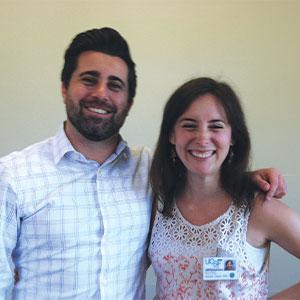 Patrick Lowerre and Rachel Larson “There’s something really special about learning from someone who has just recently learned themselves,” says Larson. “Patrick really cared about me understanding the whys and hows behind what we were doing.”
Patrick Lowerre and Rachel Larson “There’s something really special about learning from someone who has just recently learned themselves,” says Larson. “Patrick really cared about me understanding the whys and hows behind what we were doing.”
“Heather models a lot of excellent behaviors in terms of what it’s like to be a new clinician and how to train a new clinician,” says Brodsky. “She would look to me – the learner – to supply new information, to come up with a treatment plan, instead of telling me, ‘This is what I usually do.’ It was the Socratic method throughout. ‘What medicine? What dose? What side effects?’”
Bennett says the learning was mutual. “This was a great opportunity to learn a little more about NP training and scope of practice.… [I]t’s different than ours.” She says NP training seems to place less emphasis on pathophysiology and pharmacology, and more on acquiring a very practical skill set. But, she adds, having worked with NPs as lead clinicians and colleagues in the clinic, “The experienced NPs have clinical expertise in areas like HIV and chronic pain that far surpasses that of physicians.”
That may be so, but the difference in training and experience that the residents brought to their partnership was an eye-opener for many of the NP students.
“The residents’ range of training is so expansive,” says Brodsky. “They can deliver babies, provide highly skilled inpatient care, and care for people across the entire life span.… [A]nd Heather’s insights about complicated patients were so valuable – all of it was such a great learning experience.”
“The reality of NP training is that we’re trying to do the same amount of learning in less time,” says Contini. “To have someone take me through their thinking process in a supportive way was the most extraordinary learning opportunity.”
For the residents, says physician Elisabeth (Beth) Wilson – who practices and precepts medical students and residents at the Family Health Center, directs the Program in Medical Education for the Urban Underserved and co-teaches a course at the School of Nursing on managing chronic disease – “Teaching requires an independent skill set, and this is a wonderful opportunity for the residents to develop that skill set.”
Moving On
“There was an older woman who had a severe gambling addiction that was taking a huge toll on her mental health. Heather had been working with her almost three years, and she was modeling for me how to build relationships and take into account psychosocial influences that have an impact on patients’ health. Heather was so kind and patient; she took the time to know this woman and to look at the bigger picture.”
—NP Jennifer Brodsky
Despite the glowing reviews from the participants, both the NP students and the residents see room for improvement in the program at the FHC. The most consistent theme along those lines has to do with the scheduling. Residents don’t always have regular schedules, so finding a time each week for the dyads to work together is not always easy, especially if the NP students are also holding down a regular nursing job.
A few of the residents also mentioned that before starting they would have liked to have had a better understanding of where second-year NP students are in their training.
“I feel like the orientation process on both ends – mine to the family nurse practitioner program and theirs to the Family Health Center – could have been stronger, because we had to carve out additional time on our own to gain that understanding,” says Bennett. “It would also help to have a better idea of how to evaluate one another. Jennifer and I tried to touch base and give each other feedback – and we were comfortable to say what wasn’t working and what was – but it would have been nice to have a mechanism for reciprocal evaluation and have a guideline for expectations.”
Nevertheless, says Bennett: “I really loved the sessions with Jennifer. I looked forward to them – and the patients looked forward to when she was there. It was nice to work with someone who has sensitivity and humility around working with the underserved. Given the workforce issues that primary care faces – the overwhelming demand – it’s very important for physicians, NPs and PAs to learn to work together in settings like this in a team-based model.”
“I think seeing the strengths of each other’s training and practicing together in a real-world format is a really important step in creating a better interprofessional relationship,” says Brodsky.
“I thought Chris was incredible and that there should be much more of this,” adds Castillo. “As we train to become family medicine doctors, we train together with lots of specialties, but then we practice in silos and forget about our ability to communicate. That’s not good for patient care. Schools should integrate this more into the learning process; pairing an NP [student] with a resident is an incredible opportunity to understand what each other does, see each other’s strengths and set the tone for the future of health care.”

